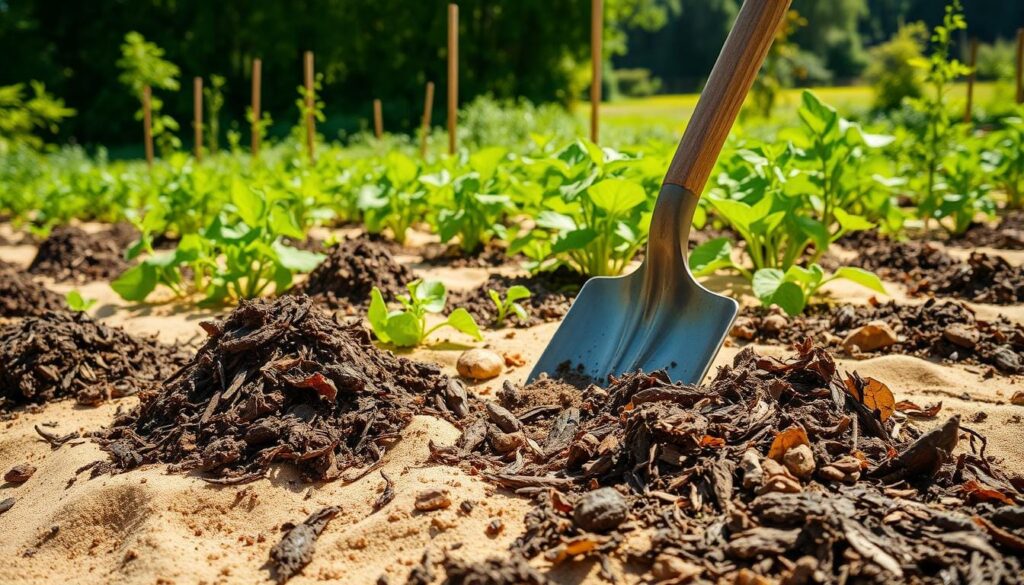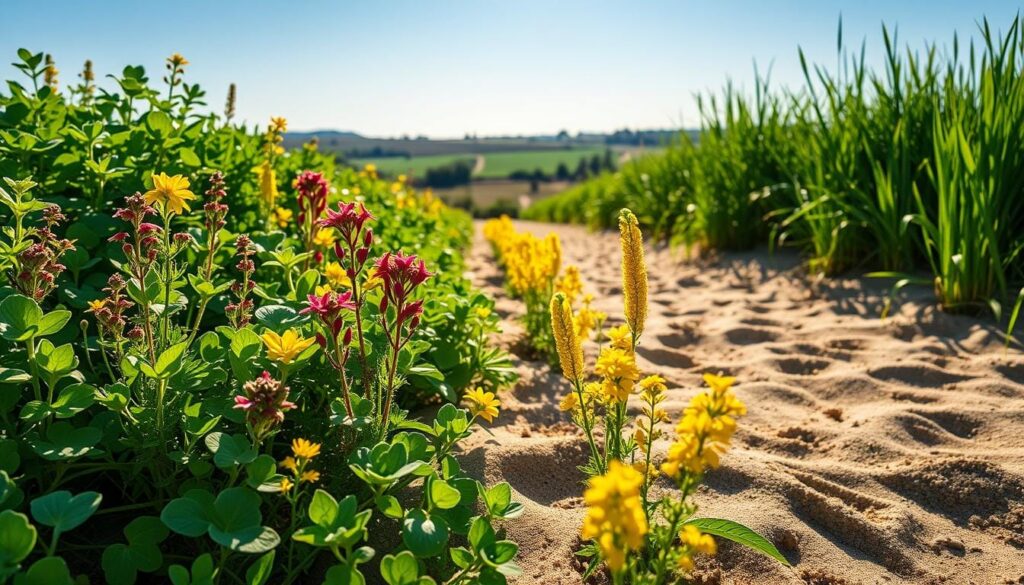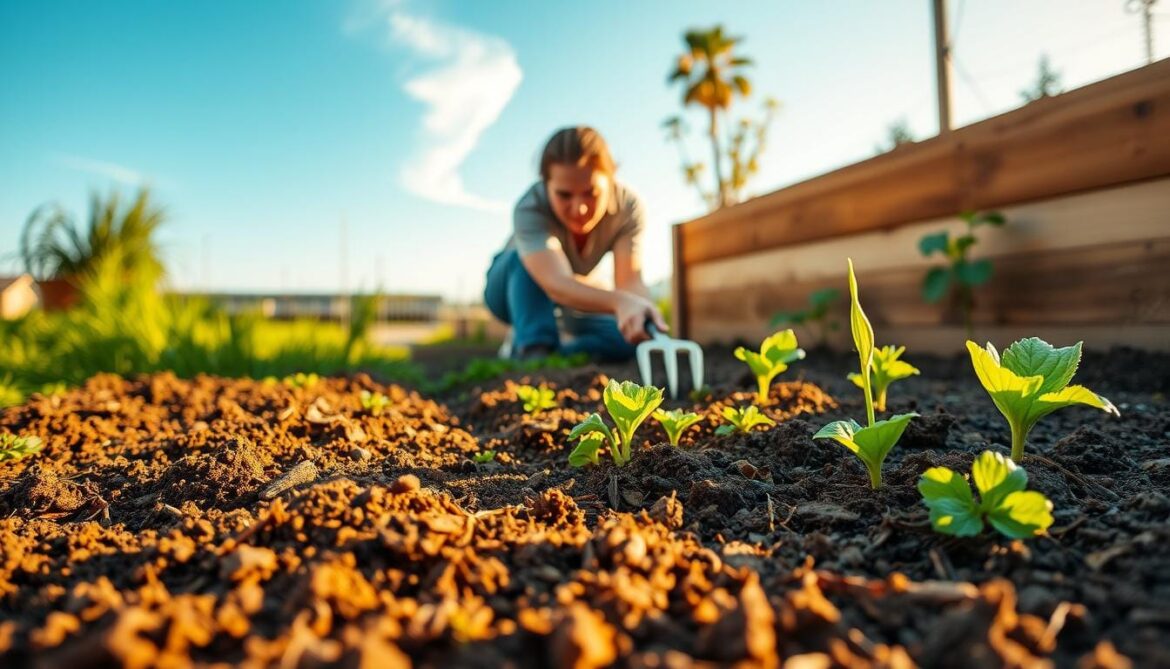Every garden has its own story, and for those with sandy soil, it can be tough. I’ve seen many gardeners fight against soil that drains water and nutrients fast. The real challenge is not just about the soil—it’s about changing it for the better.
Sandy soil is hard to work with because it’s mostly sand. This means it drains water quickly, leaving plants without the moisture and nutrients they need. But, there’s hope. With the right techniques, we can make even the toughest soil into a lush garden.
We’ll look at ways to make sandy soil better. We’ll find out how to keep water in, add nutrients, and make a place where plants can grow well.
Key Takeaways
- Sandy soil needs special care to help plants grow
- Adding organic matter is key to improving soil
- Good watering and mulching can really help soil quality
- Cover crops help bring back nutrients and stop soil erosion
- Testing your soil often is vital for a healthy garden
Understanding Sandy Soil Characteristics
Sandy soil is a unique type that can be tricky for gardeners. We’ll explore its complex nature and how to work with it effectively.
What is Sandy Soil?
Sandy soil has large, coarse particles that make it loose and gritty. These particles are between 0.05 to 2 millimeters in diameter. This size affects how the soil behaves. It’s mostly sand, making it very porous and good at draining water.
Benefits of Sandy Soil
- Excellent drainage prevents water logging
- Warms up quickly in spring, promoting early plant growth
- Provides good gas diffusion around plant roots
- Less prone to soil compaction
Drawbacks of Sandy Soil
Despite its benefits, sandy soil has big challenges. Its large particles mean it can’t hold nutrients or water well. This requires using special amendments and conditioners to improve it.
| Soil Characteristic | Sandy Soil Performance |
|---|---|
| Water Retention | Very Low (1-10 inches per hour intake) |
| Nutrient Retention | Poor |
| Organic Matter Content | Typically Low |
| Recommended Annual Organic Matter | 2 inches |
Knowing these traits is key to making your sandy soil better. By understanding its unique features, we can make targeted improvements. This will help it become a thriving garden environment.
Why We Need to Amend Sandy Soil
Gardeners face unique challenges with sandy soil. This soil type is lightweight and drains water quickly. It has large particles that can’t hold water or nutrients well, making it hard for plants to grow.
Understanding the need to enrich sandy soil is key. It helps gardeners turn tough areas into productive gardens. The main goals of soil amendment are:
- Improving nutrient retention capabilities
- Enhancing water-holding capacity
- Creating a more stable soil structure
Enhancing Nutrient Retention
Nutrients in sandy soil wash away fast. Adding organic matter helps keep nutrients in place. Slow-release fertilizers are great for these conditions, providing nutrients steadily without washing away.
Improving Water Retention
Water drains quickly through sandy soil, needing daily watering for many plants. Organic mulch and compost help keep moisture in. Experts suggest adding three to four inches of compost to improve water retention.
Increasing Soil Structure
A strong soil structure is vital for plant health. Cover crops like Hairy Vetch and Winter Rye improve soil nutrients and prevent erosion. They make the soil better for beneficial microbes and plant roots.
Transforming sandy soil is not about replacing it, but enriching its natural characteristics to support vibrant plant life.
Key Amendments for Sandy Soil
Improving sandy soil needs smart amendments to boost its fertility and structure. Adding organic matter is key to making poor soil good for plants. We focus on solutions that make sandy soil fertile and support plant health.
Organic Matter: The Foundation of Soil Health
Organic matter is essential for bettering sandy soil. Adding organic materials helps the soil hold water and nutrients better. Coconut coir, for example, can increase water and nutrient retention by up to 30% in sandy soil.
- Worm castings improve soil aeration
- Compost adds essential nutrients
- Manure increases organic content
Compost: Nature’s Soil Transformer
Compost is a strong ally for sandy soil. It brings good microbes and a steady flow of nutrients. We suggest using compost made from a mix of green and brown materials.
Mulch: Protecting and Nourishing the Soil
Mulching does many things for sandy soil. It keeps moisture in, controls soil temperature, and adds organic matter as it breaks down. Straw, wood chips, and leaf mulch are great for improving sandy soil.
Tip: Always use composted wood chips to prevent nitrogen tie-up in your garden soil.
With these key amendments, gardeners can turn tough sandy soil into a fertile and thriving place for plants.
How to Incorporate Organic Matter
Improving sandy soil structure is key to a successful garden. We need to know how to mix amendments and when to apply them. Adding organic matter helps a lot with keeping moisture in sandy soil.

- Add at least two bucketfuls of organic matter per square yard each fall
- Increase application frequency to twice yearly for underperforming crops
- Aim for 2%-5% organic matter content in garden beds
Techniques for Mixing Amendments
There are several ways to mix organic matter into your soil. Using the right techniques can make a big difference. For small gardens, manual methods are best. For bigger areas, mechanical tools like tillers are better.
- Hand mixing: Use a garden fork to gently fold compost into existing soil
- Mechanical tilling for deeper amendment integration
- Top-dressing with compost and allowing natural breakdown
Timing and Seasonal Considerations
Fall is the best time to improve your soil. Adding organic amendments before allows microbes to break them down. In warmer places, you might need to add more often because things break down faster.
Choosing the Right Fertilizers
Maintaining sandy soil fertility needs a smart fertilization plan. Sandy soils are hard to manage for nutrients, so picking the right fertilizer is key for gardening success.
Knowing how nutrients move in sandy soil helps gardeners choose the best fertilizers. Sandy soils lose nutrients fast, so old fertilization methods don’t work well.
Types of Fertilizers for Sandy Soil
Here are some top fertilizer picks for sandy soil:
- Slow-release fertilizers – Give nutrients slowly
- Organic compost – Makes soil better and keeps nutrients
- Controlled-release granular fertilizers
- Worm castings – A natural way to add nutrients
Managing Nutrient Release
Managing nutrients in sandy soils means knowing how fertilizers work. Slow-release fertilizers are great because they:
- Stop nutrients from washing away
- Give plants steady food
- Help avoid too much fertilizer
- Keep plants healthy for a long time
Good soil nutrient management is about steady, balanced delivery, not sudden floods of nutrients.
When picking fertilizers, think about what your plants need and what sandy soil is like. Look for products with at least one-third water-insoluble nitrogen for steady nutrient supply.
The Role of Cover Crops
Cover crops are a key tool for bettering sandy soil and garden health. These plants work quietly, turning poor soil into a lush garden spot.

Our plan to enrich sandy soil uses special cover crops. These plants help solve big problems in sandy areas.
Benefits of Planting Cover Crops
- Prevent soil erosion up to 90%
- Add organic matter quickly
- Improve soil structure and water retention
- Suppress weeds and manage pest cycles
- Enhance nutrient availability
Best Cover Crops for Sandy Soil
For sandy soil, some cover crops stand out. We suggest a mix of warm and cool-season types, based on your garden needs.
| Warm-Season Cover Crops | Key Benefits |
|---|---|
| Brown Top Millet | Increases water retention, improves soil tilth |
| Sorghum Sudangrass | Suppresses nematodes, improves soil aeration |
| Buckwheat | Fast-growing, manages pest cycles |
| Sunn Hemp | Excellent for nutrient-poor sandy soils |
Planting these cover crops can greatly change sandy soil. It makes your garden more fertile and productive.
Effective Water Management Strategies
Water management is key for gardens with sandy soil. Sandy soil makes it hard to keep plants healthy. We aim to find smart ways to save water in sandy soil gardens.
Gardeners with sandy soil face big challenges. These soils let water pass through quickly, not giving roots enough. Adding the right amendments can help keep water and improve plant health.
Irrigation Techniques
Effective irrigation for sandy soils needs a careful plan:
- Use slow, deep watering to help roots grow
- Install drip irrigation for exact water delivery
- Apply soaker hoses to cut down on evaporation
- Water in the early morning or late evening to save moisture
Rainwater Harvesting
Rainwater harvesting is a great way to keep sandy soil moist. It lets gardeners:
- Use less municipal water
- Give plants clean water
- Save water overall
- Deal with water shortages better
By 2050, global water demand will increase a lot. So, saving water is vital for gardeners and farmers.
Good water management and the right soil amendments can make tough gardens better. They can turn challenging areas into thriving landscapes.
Creating a Balanced Soil pH
Soil pH is key to keeping sandy soil fertile. Sandy soils often have pH issues, affecting nutrient use and plant health. We aim to help gardeners achieve the best growing conditions by managing acidity and alkalinity well.
Testing Soil pH Accurately
Soil pH testing is the first step for managing sandy soil. We suggest using professional kits for accurate readings. The pH scale is from 0 to 14, with 7 being neutral:
- Acidic soils: pH below 7
- Neutral soils: pH of 7
- Alkaline soils: pH above 7
Understanding pH Impact on Plant Growth
Plants grow best in certain pH ranges. Vegetable gardens and most ornamentals do well in slightly acidic soils between 5.8 and 6.5. Some plants have special needs:
| Plant Type | Preferred pH Range |
|---|---|
| Azaleas and Rhododendrons | 5.0 – 5.5 |
| Most Vegetables | 5.8 – 6.5 |
| Blueberries | 4.5 – 5.5 |
Adjusting Soil pH Effectively
Adjusting pH in sandy soils needs a careful plan. To raise pH, use agricultural limestone. To lower it, apply elemental sulfur or aluminum sulfate. Here are tips for sandy soil:
- Test current soil pH
- Determine target pH for desired plants
- Choose appropriate amendment
- Apply gradually to avoid shock
Remember, keeping the right pH balance is vital for sandy soil fertility. Proper management ensures nutrients are available and plants thrive.
Plant Selection for Sandy Soil
Gardening in sandy soil needs smart choices and techniques. Knowing which plants do well in these conditions can make a big difference. The right plants and soil amendments can improve sandy soil.
Sandy soils are tough, but many plants love them. The trick is picking plants that are good at handling quick-draining, nutrient-poor soil.
Best Plants for Sandy Conditions
Here’s a list of top plants for sandy soil:
- Drought-Tolerant Herbs: Lavender, rosemary, and yarrow
- Flowering Perennials: Coneflowers, sedum, daylilies
- Vegetable Crops: Carrots, radishes, garlic, peppers
- Fruit Plants: Strawberries, blueberries
Companion Planting Techniques
Companion planting can make sandy soil better. It helps plants work together to manage moisture and nutrients. This boosts garden health.
| Plant Combination | Benefits |
|---|---|
| Tomatoes + Basil | Improves flavor, repels pests |
| Carrots + Onions | Deters carrot flies, maximizes space |
| Peppers + Marigolds | Reduces nematode populations |
Choosing the right plants and using companion planting can lead to a thriving garden in sandy soil.
Regular Maintenance Practices
Maintaining healthy sandy soil is a long-term effort. It’s not just about adding nutrients once. It’s about ongoing care and attention. Knowing how to manage sandy soil is key to a successful garden.
Soil testing is the first step in managing sandy soil. We suggest testing your soil twice a year. The best times are early spring and late fall. This helps you understand your soil’s health.
Essential Soil Testing Procedures
- Collect soil samples from multiple garden areas
- Use professional soil testing kits or local agricultural extension services
- Analyze pH levels and nutrient composition
- Document test results for future reference
Seasonal Care Strategies
Seasonal care is vital for sandy soil. Each season has its own needs to keep the soil healthy.
- Spring: Add fresh organic matter and test the soil
- Summer: Mulch and keep the soil moist
- Fall: Plant cover crops and protect the soil
- Winter: Plan for the next year and review soil health
“Healthy soil is the foundation of a thriving garden” – Sustainable Gardening Experts
With these maintenance steps, you can turn sandy soil into a great place for plants. Regular care, smart amendments, and constant monitoring will make your soil strong. This will help your plants grow well.
Conclusion: Building Healthy Sandy Soil
Turning sandy soil into a fertile garden takes dedication and smart strategies. We’ve shown that making sandy soil fertile is doable with the right methods. It’s not a hard task.
We’ve looked at ways to make sandy soil better, like adding organic matter and managing water well. Using leaf mold, aged manure, and methods like mulching and drip irrigation can greatly help. These steps improve soil structure and keep nutrients in.
Regular soil tests, adding organic matter yearly, and choosing the right plants are key. Remember, improving soil is a long-term effort that needs patience and care. With the right steps, your sandy soil can become a rich base for a lively garden.
See the chance in your sandy soil. With effort and the right knowledge, you can turn it into a lush, fertile place. It will support healthy plants and eco-friendly gardening.

